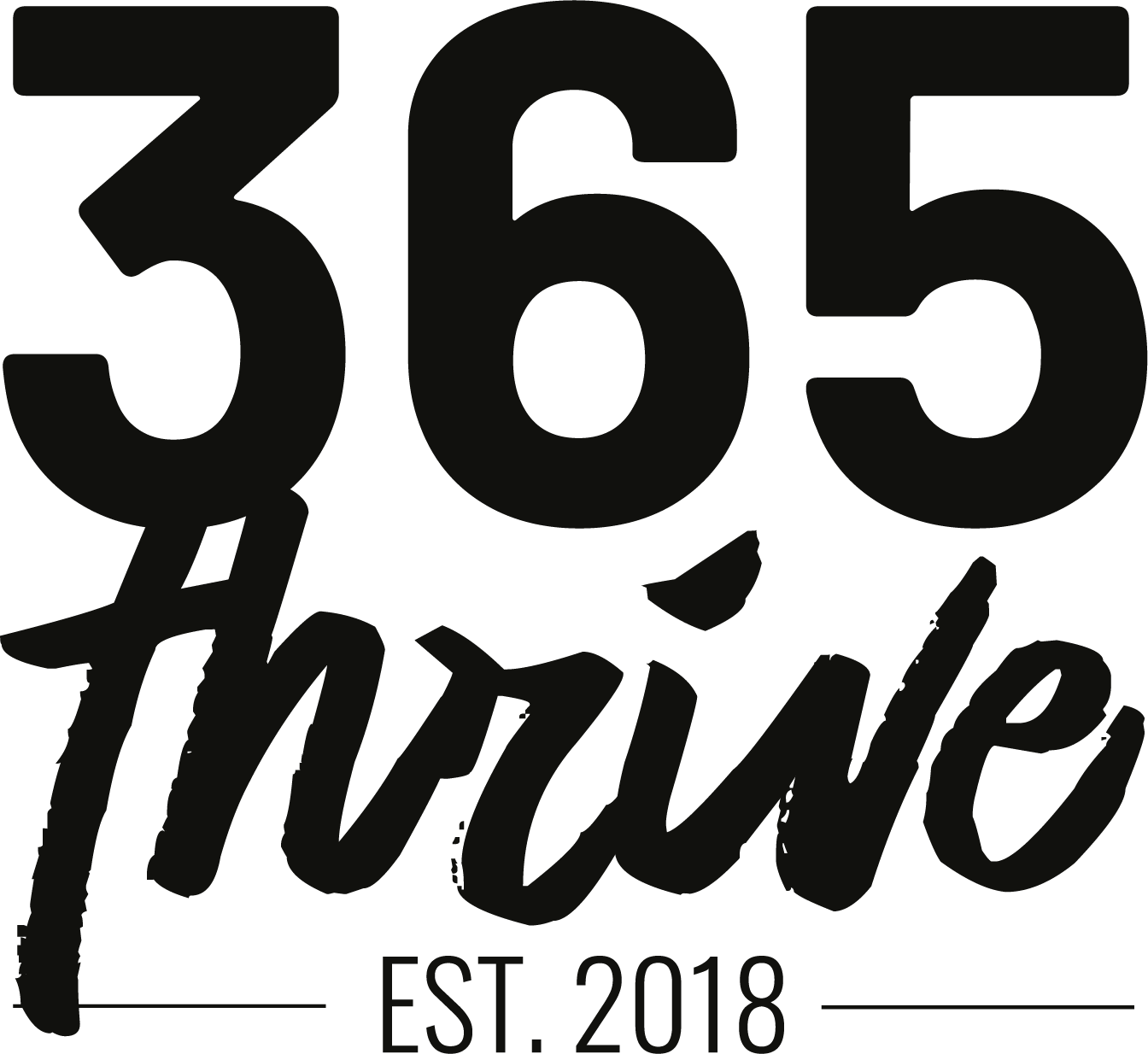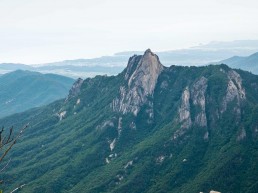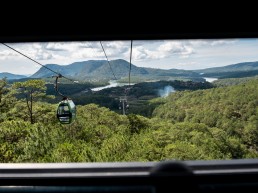South Korea is one of those places that I don’t think we actually ever expected to go. And yet we somehow found ourselves spending 2 weeks there back in the summer of 2019 and despite a few wobbles in terms of some rather interesting local specialities (raw fish soup, anyone?) we had an amazing time exploring. The country is absolutely full to the brim of things to do, see and eat. It has everything you could begin to expect in terms of big, bustling cities but also some cheeky surprises in the form of Jeju Island and its many national parks. If you’re intrigued by South Korea and want to embrace everything the country has to offer, you can easily spend 2 weeks (or more!) exploring. However, if you have less time, we have recommendations for how to squeeze in as much as possible into one week. Here is our ultimate guide to 2 weeks in South Korea.
Firstly, be sure to check out our (albeit, brief) vlog series from our 2 week trip there. We vlogged Seoraksan national park, Jeju island and Busan but unfortunately didn’t capture Seoul as were in need of a daily vlogging break by that point! Check out the series here.
The itinerary
Whilst we spent 2 weeks in the country, we did limit the number of places to 4 that we explored so as not to feel like we were hopping around like crazy people. However, if you feel like you’d rather squeeze in a little more, then see our recommended add-ons below.
2 weeks (13 nights):
Seoul – 4 nights
Sokcho & Seoraksan national park – 2 nights
Jeju island – 4 nights
Busan – 3 nights
1 week (6 nights):
Seoul – 3 nights
Sokcho & Seoraksan national park – 1 night
Busan – 2 nights
If you only have a few days, it’s best to stick to exploring Seoul and possibly venturing out to Seoraksan national park if you don’t mind spending a couple of hours on a bus (each way).
Optional add-ons:
If you have more time on your hands then head to Jeonju, one of the oldest cities in the country. Here you can fully immerse yourself in Korean culture, history and spicy bibimbap. If this sounds more up your street than beaches and waterfalls, you can always trade 4 nights on Jeju Island for Jeonju.
First things first…currency and costs
The currency used in South Korea is the Korean Won (KRW) which is roughly 10,000 KRW to £6.50 GBP or $9 USD. As with any trip you can spend as much or as little as you would like depending on how you travel. Staying in hostels and eating local food will always be cheaper than hotels and restaurants. Plus the number of paid activities you do will have an impact on your overall spend.
As a rough guide, we would describe South Korea as moderate in terms of expense. Whilst it is not as cheap as South East Asia, it is certainly cheaper than parts of Western Europe, for example. Here are a few rough prices to give you an idea of costs:
Average very basic hotel room (double): 40,000 KRW (£26 GBP)
Average dinner (low-end restaurant, for two): 20,000 KRW (£13 GBP)
Average entrance to tourist spots (waterfalls, palaces): 3,000 (£2 GBP)
Average cup of coffee: 4,300 KRW (£2.80 GBP)
Language barrier & ease of getting around
Whilst South Korea is one of the more challenging countries to explore due to the language barrier, there will be some people (especially in major cities) who will speak English, especially younger people. We always managed to find someone to help us navigate bus stations and everywhere we stayed had someone who spoke English.
That being said, it can be a bit tricky to navigate not only because of the language barrier but due to the fact that google maps will not work in the country. It wasn’t until we spent 2 weeks in South Korea that we realised how much we relied on google maps for planning trips, routes and finding places to eat and visit. The alternative app to use is called Naver, however we found this to not work as well as google maps.
In terms of getting around the country, there are many long distance buses and train routes to get you to and from the major cities. We used a combination of long distance buses and domestic flights to get around the country and were impressed with both for the cost and the high standard. For example, the 2.5 hour bus journey we took from Seoul to Sokcho on the east coast cost just over 30,000 KRW (£20 GBP) for the two of us and was possibly the nicest bus we had been on throughout the whole of Asia (even including Japan).
For speed, ease and surprisingly, cost, we actually opted for internal domestic flights to get us from Seoul to Jeju Island and then from Jeju island on to Busan. These flights were such good value at from only £15 GBP each (including 15kg luggage) that it made the most sense to fly instead of spending many more hours on buses or trains. Look in to your options for your dates as you may be surprised at the prices!
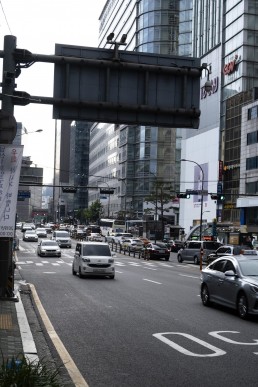
When to go
South Korea, unlike many Asian countries, has four distinct seasons with temperatures ranging from an absolute low of -20C in winter (in northern mountainous regions) to highs of 30C in the summer (on Jeju island, for example). The consensus is that spring is the best time to go with moderate temperatures of 15-18C.
We went in June and found it to be very pleasant weather, had no rain at all and yet it wasn’t too hot that you couldn’t enjoy the cities or hiking. Naturally, the most popular times will be the busiest and also be sure to check national and school holidays as these will increase costs of hotels.
Visas, vaccinations and safety
UK citizens do not need a visa to visit South Korea as stated on the UK government website: ‘If you have a British Citizen passport you can enter South Korea as a tourist for up to 90 days without a visa.’. There are many other countries such as Canada and the US who also do not require a visa but be sure to check your official government website before travelling.
In terms of vaccinations, as a UK citizen, be sure to check the NHS Fit for Travel website for all of the recommended vaccinations to get prior to travel. Allow plenty of time before your trip as some jabs need to be given weeks prior to travel.
When it comes to safety, South Korea is considered a safe country to travel to. Walking around a city, taking taxis and having your phone out, for example, are all relatively safe to do as long as the usual precautions are taken. We never once felt unsafe during our two weeks spent in the country but of course, like anywhere you go (including your own home town!) just be aware of your surroundings and belongings.
Despite the fact that South Korea is technically still at war with North Korea, that is not something that will directly effect your experience as a tourist. However, always be sure to check travel advice before travelling.
Getting there
Typically you’ll fly in to Seoul’s major airport, Incheon International Airport. This happens to be roughly 45 miles from the centre of the city. It is relatively easy to get into the city either by the airport railroad (AREX), airport bus (runs 24/7) or taxi. We opted for the bus as we happened to arrive very late at night and so the late night bus was our best option. It is a reasonable cost at approximately 10,000 – 15,000 KRW (£6.50 – £10 GBP) per person depending on your stop.
Exploring Seoul
Seoul is a fantastic city to explore with so much to see and do with many activities and tourist spots either free or very fairly priced. We stayed at The Stay Hotel Myeongdong, a budget hotel in the popular Myeongdong shopping area which was a great base for us as we love to walk as much as possible without getting transport. Whilst it was very basic, it had everything you need and was a great location for shopping, eating and was only a few minutes walk from Myeongdong Subway Station.
The Myeongdong shopping area is a great place to explore by foot, with countless shops with some of the cutest items imaginable as well as many places to try local food. Wander through the streets, grab a crazy tall ice cream and marvel at the fashion and street art. You could easily spend an entire day alone here, especially if you’re a lover of street photography (and cute stationery).
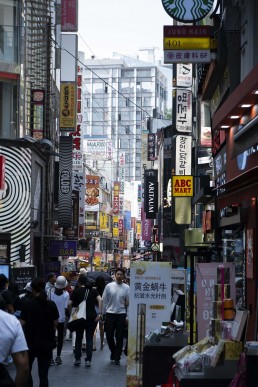
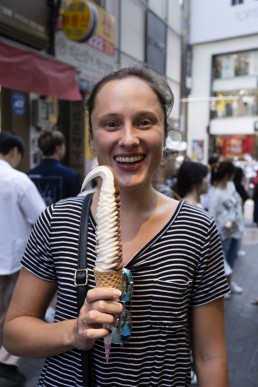
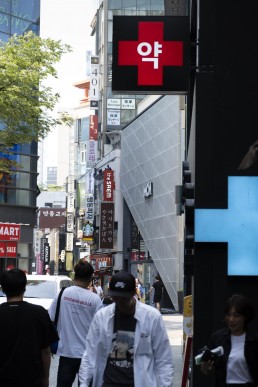
There are 5 Royal palaces across the city to visit including Changdeokgung Palace, Changgyeonggung Palace and Gyeongbukgung Palace. The most impressive and perhaps most historically significant being Gyeongbukgung as it was the first and main royal palace of the Joseon dynasty. The palace is a great place to explore, with beautiful gardens, temples and grounds and at an entrance price of only 3,000 KRW (adults) it’s a budget-friendly way to spend a morning.
You can even hire ‘hanboks’ in various places around the city for a day to explore the sights whilst wearing the traditional formal wear from the Joseon period. Whilst it’s not for everyone, it does certainly make for great photos and dare I say it, makes everywhere you go very ‘instagrammable’.
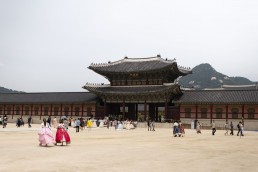
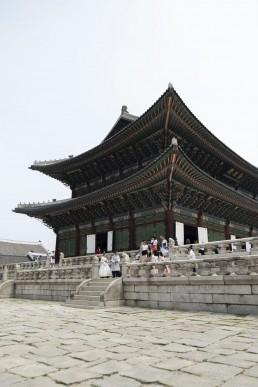
Not too far from the Gyeongbukgung Palace is the popular Bukchon Hanok village. This small area of Seoul is full to the brim of traditional ‘hanock’ houses, some of which are open to the public. The narrow alleyways and traditional homes are great to explore and give you the chance to immerse yourself in the ‘old’ South Korea.
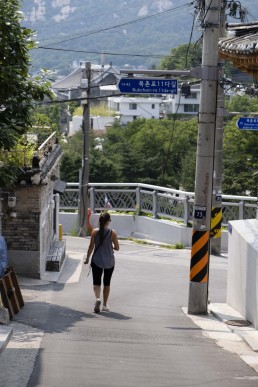
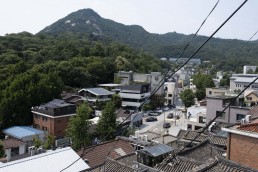
For far-reaching view across the city, head to the N Seoul Tower in Namsan Park. Situated close to Myeondong, we actually walked up to the top from where we were staying. Alternatively, you can jump on a cable car to the top or even drive up there. On a clear day you can see across Seoul and the surrounding areas for miles.
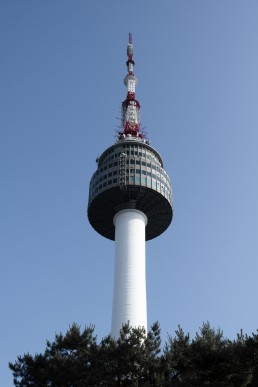
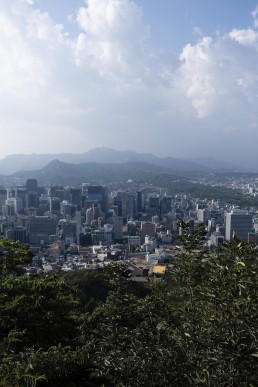
To learn more about the history of the conflict between South Korea and North Korea, a day trip to the DMZ is another must do. You’ll need to book on to a tour to visit and be sure to follow all instructions and protocols whilst on the trip.
These are just the tip of the iceberg when it comes to things to do in Seoul. As with all cities, the list goes on and there is so much more to see including incredible markets, nightlife, drinking and karaoke. There’s also of course many traditional dishes to try from Korean BBQ and Bibimbap to ice creams and street food.
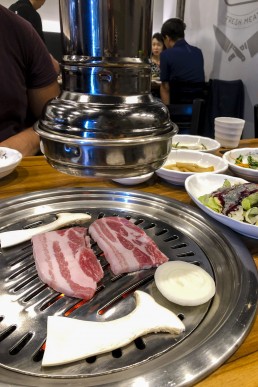
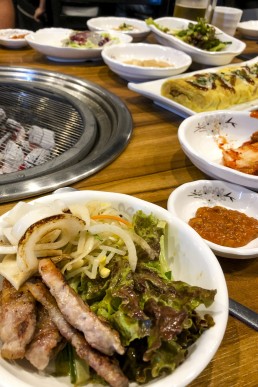
Sokcho & Seoraksan National Park
From East Seoul bus terminal you can catch a bus quite easily to Sokcho on the east coast. The 2.5 hour bus journey costs just over 30,000 KRW (£20 GBP) for two and leaves every 30 minutes. A great place to stay for its affordability and central location is James Blue Hostel. The hostel is ran by James (obviously…) who is so friendly and more than happy to give you recommendations for the area.
Whilst the main reason to head to Sokcho is to climb Ulsanbawi Rock in Seoraksan National Park, the seaside tourist spot is worth exploring if you have a little extra time. On our free afternoon upon arriving in Sokcho we headed to Sokcho beach and wandered along the coast. If you’re a seafood lover you’ll find plenty to eat, however, if like us, you really aren’t a fan then you may struggle a little. Along those same lines, there is a well-known fish market in town called Jungang fish market, the perfect place to visit for an authentic local experience (if you can stomach the smell of lots of raw fish, that is!).
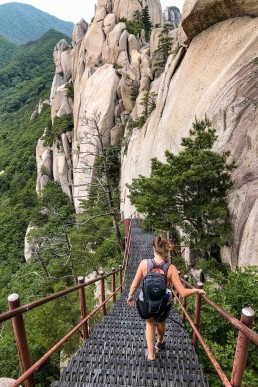
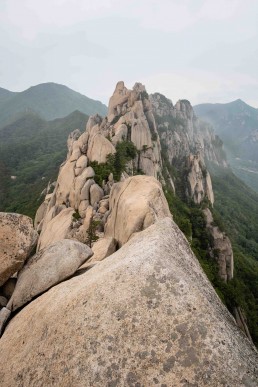
A trip to South Korea would not be complete without getting out into the countryside and going on a hike. We knew that we simply had to climb Ulsanbawi rock after seeing some photos of it online and it certainly did not disappoint. Check out our blog post on hiking ulsanbawi rock for all the details on how to get there, what to expect and what to take. It really is an unforgettable experience!
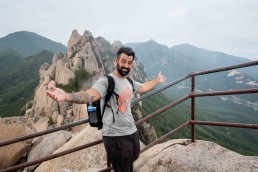
Exploring Jeju island
From Sokcho, take the bus back to Seoul to jump on a short domestic flight to Jeju island. Jeju is often referred to as the ‘Hawaii of South Korea’ due to its abundance of lush countryside, beaches, waterfalls and relaxed vibe and is a popular holiday spot for South Koreans.
A popular area to stay in is Seogwipo on the southern side of the island. However, attractions are relatively spread out across the island so hiring a car would be a great option for speed and ease. If this is a bit of a budget-buster, there is a local bus which is always an option. Of course, this is what we did BUT bear in mind that it does make getting to things much more challenging.
We stayed in Seogwipo at a guesthouse called Mimong. The owners were very friendly, spoke English and the breakfast provided was definitely one of the better ones we had during our 2 weeks in South Korea.
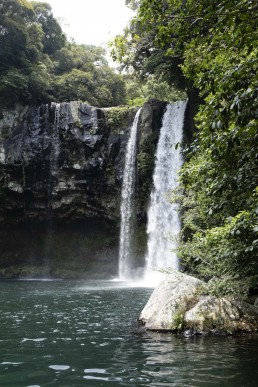
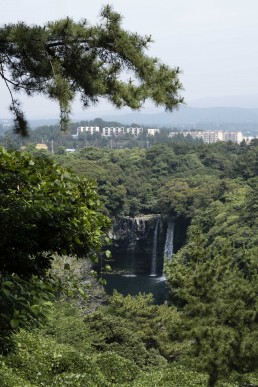
As for things to do, well, there is plenty. From hikes and waterfalls to beaches and scuba diving, it has a little something for everyone. A main attraction is the volcano Halla-san, South Korea’s highest peak at 1,950m surrounded by a Unesco World Heritage listed national park. Climbing the peak is a strenuous 18km hike and surprisingly enough, one we didn’t do! I know, shock. There are many other options for hikes including the dormant volcano, Seongsan Ilchul-bong and the 26 hiking paths across the island named the ‘Olle trails’.
If chasing waterfalls is more your kind of thing then you’re in luck as there are plenty on the island including Cheonjiyeon waterfall and Jeongbang waterfall, both of which are not too far from Seogwipo centre. There are also countless sandy beaches to chill out and really embrace that island life.
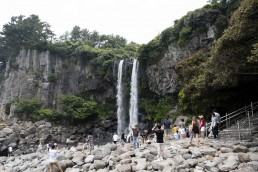
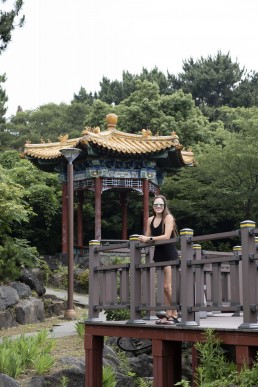
A truly unique experience to have on the island would be to go scuba diving off of Moon island to the south of Seogwipo. After learning to dive on the beautiful island of Koh Tao, Thailand where we didn’t even need wet-suits, the experience in South Korea was very different. The water temperature for one was a bit of a shock to the system and full wetsuits, boots and gloves were required.
You’ll see black volcanic rocks, vertical walls covered in coral and giant kelp forests along with a large variety of fish. It is truly a unique diving experience! Stay tuned for a separate post all on what to expect when going scuba diving in Jeju, who we recommend going with and more!
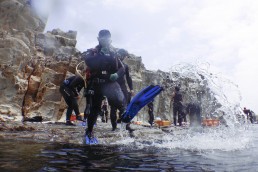
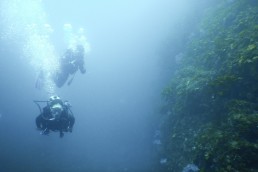
Exploring Busan & Gamcheon culture village
From Jeju island, it’s another quick and easy domestic flight back to the mainland to Busan. South Korea’s second largest city, Busan is packed to the brim of things to do and see. The large port city has a mountainous backdrop, the largest seafood market in the country, Buddhist temples, beaches and even the largest department store in the world – yes, world.
We booked our stay at Hotel 25 Seomyeon but actually ended up staying at Hotel 2 Heaven next door due to construction work at the time (June 2019). It’s conveniently located only a short walk from Beomnaegol metro station and is well priced for the size and cleanliness of the rooms.
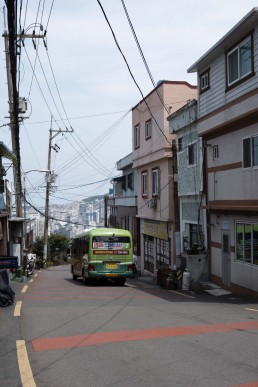
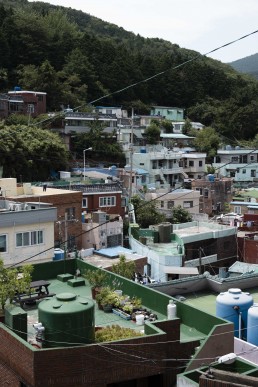
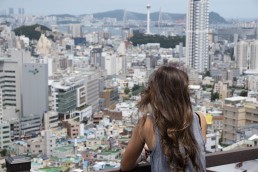
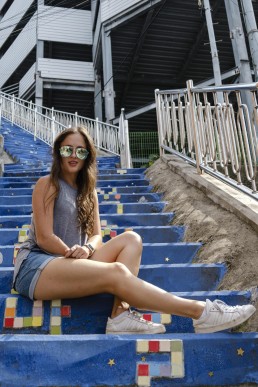
One of the most popular things to do in Busan is to explore Gamcheon Culture village. This colourful network of alleyways, houses, cafes and shops that once used to be a neglected slum is now a popular tourist spot. Back in 2009 students gave the mountainside slum a makeover, painting the houses and alleyways in bright colours. Spend an afternoon wandering the streets, taking photos and exploring the little shops. Some of our favourite alleyways and murals were actually on the walk from the metro station (Toseong Station) to the official start point of the village. Exploring the area is free but you can buy a map of the area for the small fee of 2,000 KRW (£1.30 GBP).
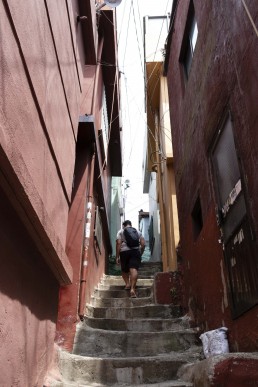
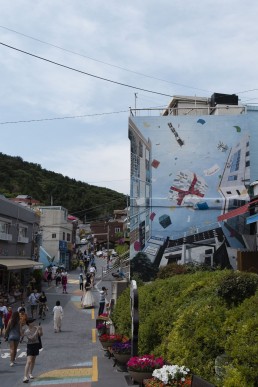
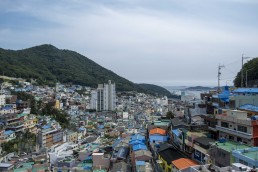
Another great way to spend an afternoon is to hop on over to Haeundae beach, one of the most popular beaches in the country. The long, sandy beach is just a short walk from downtown Busan and has a pretty incredible backdrop of towering skyscrapers. Walking away from the beach you’ll find plenty of restaurants, markets and shops as well as a great little craft beer place called Galmegi Brewing. Order a tasting flight of craft beer and watch the world go by on the bustling streets below.
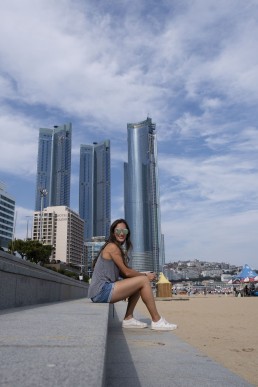
As you can see, 2 weeks in South Korea is very easily filled up. There is so much to see and do from bustling cities and sandy beaches to beautiful national parks and even unique scuba diving. And whilst it wasn’t our favourite country for food, if you are a seafood lover you will have much more luck than us!
Have you been to South Korea? What were your favourite things to do?
Happy adventuring,
Lorna
Share
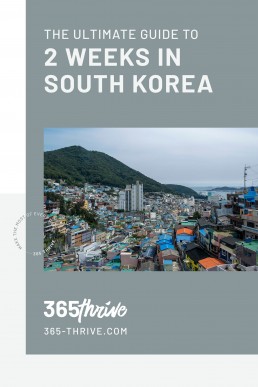
SOUTH KOREA VLOG SERIES
We have a whole vlog series on youtube from our trip to South Korea – check them out over on our channel by clicking below.
Related posts
Hiking Ulsanbawi Rock in Seoraksan National Park, South Korea
If you’ve been following our youtube channel then you’ll know we are always walking, always hiking…
The ultimate guide to Dalat, Vietnam
During the 4 weeks we spent in Vietnam, the small city of Dalat was without a doubt one of our…
